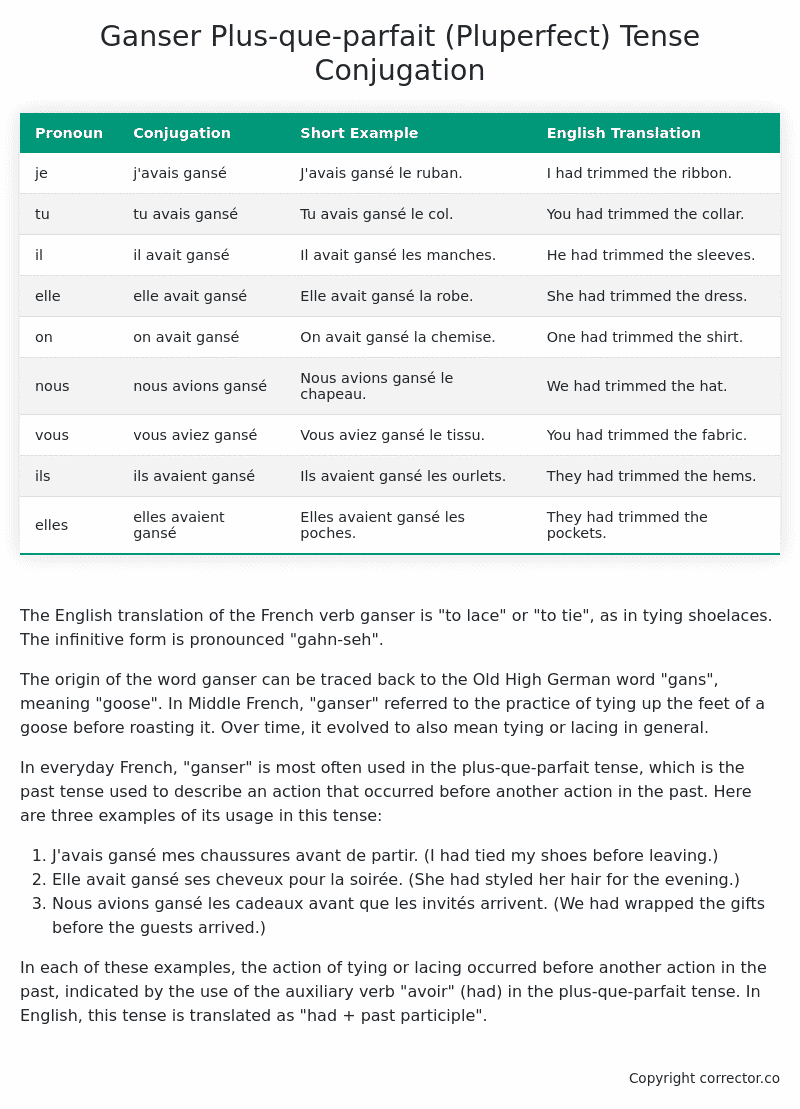Plus-que-parfait (Pluperfect) Tense Conjugation of the French Verb ganser
Introduction to the verb ganser
The English translation of the French verb ganser is “to lace” or “to tie”, as in tying shoelaces. The infinitive form is pronounced “gahn-seh”.
The origin of the word ganser can be traced back to the Old High German word “gans”, meaning “goose”. In Middle French, “ganser” referred to the practice of tying up the feet of a goose before roasting it. Over time, it evolved to also mean tying or lacing in general.
In everyday French, “ganser” is most often used in the plus-que-parfait tense, which is the past tense used to describe an action that occurred before another action in the past. Here are three examples of its usage in this tense:
- J’avais gansé mes chaussures avant de partir. (I had tied my shoes before leaving.)
- Elle avait gansé ses cheveux pour la soirée. (She had styled her hair for the evening.)
- Nous avions gansé les cadeaux avant que les invités arrivent. (We had wrapped the gifts before the guests arrived.)
In each of these examples, the action of tying or lacing occurred before another action in the past, indicated by the use of the auxiliary verb “avoir” (had) in the plus-que-parfait tense. In English, this tense is translated as “had + past participle”.
Table of the Plus-que-parfait (Pluperfect) Tense Conjugation of ganser
| Pronoun | Conjugation | Short Example | English Translation |
|---|---|---|---|
| je | j’avais gansé | J’avais gansé le ruban. | I had trimmed the ribbon. |
| tu | tu avais gansé | Tu avais gansé le col. | You had trimmed the collar. |
| il | il avait gansé | Il avait gansé les manches. | He had trimmed the sleeves. |
| elle | elle avait gansé | Elle avait gansé la robe. | She had trimmed the dress. |
| on | on avait gansé | On avait gansé la chemise. | One had trimmed the shirt. |
| nous | nous avions gansé | Nous avions gansé le chapeau. | We had trimmed the hat. |
| vous | vous aviez gansé | Vous aviez gansé le tissu. | You had trimmed the fabric. |
| ils | ils avaient gansé | Ils avaient gansé les ourlets. | They had trimmed the hems. |
| elles | elles avaient gansé | Elles avaient gansé les poches. | They had trimmed the pockets. |
Other Conjugations for Ganser.
Le Present (Present Tense) Conjugation of the French Verb ganser
Imparfait (Imperfect) Tense Conjugation of the French Verb ganser
Passé Simple (Simple Past) Tense Conjugation of the French Verb ganser
Passé Composé (Present Perfect) Tense Conjugation of the French Verb ganser
Futur Simple (Simple Future) Tense Conjugation of the French Verb ganser
Futur Proche (Near Future) Tense Conjugation of the French Verb ganser
Plus-que-parfait (Pluperfect) Tense Conjugation of the French Verb ganser (this article)
Passé Antérieur (Past Anterior) Tense Conjugation of the French Verb ganser
Futur Antérieur (Future Anterior) Tense Conjugation of the French Verb ganser
Subjonctif Présent (Subjunctive Present) Tense Conjugation of the French Verb ganser
Subjonctif Passé (Subjunctive Past) Tense Conjugation of the French Verb ganser
Subjonctif Imparfait (Subjunctive Imperfect) Tense Conjugation of the French Verb ganser
Subjonctif Plus-que-parfait (Subjunctive Pluperfect) Tense Conjugation of the French Verb ganser
Conditionnel Présent (Conditional Present) Tense Conjugation of the French Verb ganser
Conditionnel Passé (Conditional Past) Tense Conjugation of the French Verb ganser
L’impératif Présent (Imperative Present) Tense Conjugation of the French Verb ganser
L’infinitif Présent (Infinitive Present) Tense Conjugation of the French Verb ganser
Struggling with French verbs or the language in general? Why not use our free French Grammar Checker – no registration required!
Get a FREE Download Study Sheet of this Conjugation 🔥
Simply right click the image below, click “save image” and get your free reference for the ganser Plus-que-parfait tense conjugation!

Ganser – About the French Plus-que-parfait (Pluperfect) Tense
Tense Formation
Common everyday usage patterns
Sequencing of past events
Background information
Hypothetical or reported speech
Interactions with other tenses
Summary
I hope you enjoyed this article on the verb ganser. Still in a learning mood? Check out another TOTALLY random French verb conjugation!


